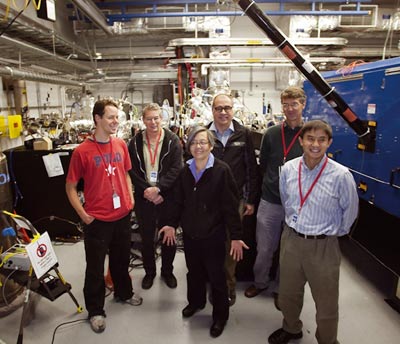
Image credit: Brad Plummer, SLAC.
The first experiments are now under way using the world’s most powerful X-ray laser, the Linac Coherent Light Source (LCLS), located at the SLAC National Accelerator Laboratory. With 10,000 million times the brightness of any other man-made X-ray source, the light from the LCLS can resolve detail the size of atoms, enabling the facility to break new ground in research in many fields including physics, structural biology, energy science and chemistry.
The LCLS takes short pulses of electrons accelerated in SLAC’s linac and directs them through a 100 m stretch of alternating magnets that force the electrons to slalom back and forth. This motion makes the electrons emit X-rays, which become synchronized as they interact with the electron pulses, thus creating the world’s brightest X-ray laser pulse. Each of these laser pulses has 1012 X-ray photons in a bunch only 100 fs long.
Commissioning assisted by users is currently under way, with experiments taking place using the Atomic, Molecular and Optical (AMO) science instrument, the first of six instruments planned for the LCLS. In these first experiments, the researchers are using X-rays from the LCLS to gain an in-depth understanding of how the ultrabright beam interacts with matter.
Early studies are revealing new insights into the fundamentals of atomic physics and have successfully proved the machine’s capabilities to control and manipulate the underlying properties of atoms and molecules. Researchers have used the pulses from the LCLS to strip neon atoms completely of all of their electrons. They have also watched for two-photon ionization. This is normally difficult to observe at X-ray facilities, but the extreme brightness of the laser beam at the LCLS makes the study of these events possible.
Future AMO experiments will create stop-action movies of molecules in motion. The quick, short, repetitive X-ray bursts from the LCLS enable experiments to form images as molecules move and interact. By stringing together many such images to make a movie, researchers will be able to watch the molecules of life in action, view chemical bonds forming and breaking in real time and see how materials work on the quantum level.
The LCLS is a testament to SLAC’s leadership in accelerator technology. Four decades ago, the laboratory’s 3 km-long linear accelerator began to reveal the inner structure of the proton. Now, this same machine has been revitalized for pioneering research at the LCLS. By 2013, all six LCLS scientific instruments will be on-line and operational, providing unprecedented tools for a range of research in material science, medicine, chemistry, energy science, physics, biology and environmental science.





